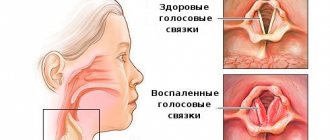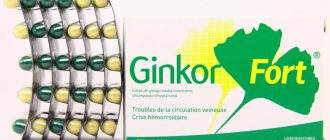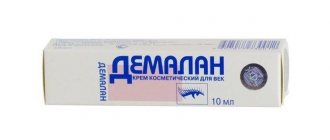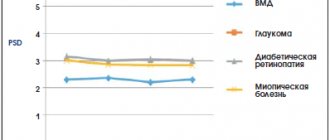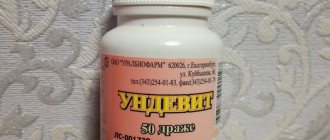Properties and composition of Fluimucil
The drug Fluimucil for inhalation is a representative of the pharmacotherapeutic group of combined antibacterial agents. This means that the medicine contains two active components: the antibacterial substance thiamphenicol; mucolytic (thinning bronchial secretion) - acetylcysteine.
Together, both substances form a substance called thiamphenicol glycinate acetylcysteinate. After absorption, it breaks down into thiamphenicol and acetylcysteine, as a result of which each component exhibits its pharmacodynamic and pharmacokinetic properties separately in the body. Fluimucil is available in the dosage form of a lyophilisate for inhalation or injection.
The mechanism of action (pharmacodynamics) of thiamphenicol is based on blocking the synthesis of protein structures of microbial cell membranes. This property manifests itself against such microorganisms as: strepto- and staphylococci; clostridia; Haemophilus influenzae (influenza bacilli) and other infectious agents that most often provoke respiratory pathologies. Acetylcysteine exerts its secretolytic effect by damaging the disulfide bonds of mucoproteins, resulting in a decrease in viscosity and easier evacuation of sputum and pus. Under the influence of acetylcysteine, the antibacterial agent thiamphenicol enters the lungs more freely, preventing bacteria from settling on the respiratory mucous membranes.
Indications for use
Fluimucil is prescribed as an inhalation for the treatment of infectious and inflammatory diseases of the upper and lower respiratory organs, the symptom of which is cough
:
- tonsillitis;
- rhinitis;
- sinusitis;
- laryngitis;
- pharyngitis;
- tracheitis;
- bronchotracheitis
- pneumonia
- bronchiectasis
- whooping cough
- interstitial lung diseases
- bronchitis in acute and chronic form
- lung abscesses
Also, indications for the use of Fluimucil are coughs due to acute respiratory infections or acute respiratory viral infections. In some cases, the drug is used to treat otitis media.
The antibiotic product is also effective for pulmonary cystic fibrosis, amyloidosis, fibrosis, tuberculosis, since it destroys staphylococci, Haemophilus influenzae, streptococci and other pathogens.
The drug can be used as a prophylactic agent to prevent unwanted complications in the postoperative period.
May be prescribed before the procedure of aspiration of bronchial mucus and bronchoscopy. Sometimes prescribed to improve drainage in lung infections such as tuberculosis. It must be remembered that this inhalation medicine can only be prescribed by a doctor. If the drug is used independently, the patient's condition may worsen.
How to breathe fluimucil through a nebulizer?
This form of Fluimucil is most often used by inhalation. For aerosol therapy, 3-9 ml of a 10% solution is sprayed in ultrasound devices, and 6 ml of a 10% solution is sprayed in devices with a distribution valve. Duration of inhalation - 15-20 minutes; frequency - 2-4 times a day. When treating acute conditions, the average duration of therapy is 5-10 days; for long-term therapy of chronic conditions, the course of treatment is up to 6 months.
Due to the high safety of the drug, the frequency of administration and the relative dose can be changed by the doctor within acceptable limits, depending on the patient’s condition and the therapeutic effect. There is no need to change the adult dose when using the drug to treat children.
Also, Fluimucil solution for injection and inhalation is used locally, for example, instilled into the external auditory canal and nasal passages, intratracheally, parenterally in a hospital setting. The duration of treatment should be determined based on changes in the patient's condition. High local and general tolerability of the drug allows for long courses of treatment.
For intravenous administration, the solution is further diluted with 0.9% NaCl solution or 5% dextrose solution in a 1:1 ratio. The duration of therapy is determined individually (no more than 10 days). In patients over 65 years of age, the minimum effective dose is used.
Composition and release form of Fluimucil
The drug is a clear and colorless liquid with a faint sulfur odor. When exposed to oxygen for a long time, the solution may acquire a pinkish or purple tint.
Fluimucil is available in ampoules for inhalation and injection, the volume of which is 3 ml. The main component of the drug is acetylcysteine. Additional chemical components of the drug are:
- disodium edetate;
- caustic soda (sodium hydroxide);
- water for injections.
All these substances together form the mucolytic agent Fluimucil (solution for injection and inhalation).
How to prepare liquid for a nebulizer?
To understand how to properly dilute the antibiotic for inhalation “Fluimucil”, you need to read the instructions for use, which describe the following scheme: Mix one ampoule of the drug (the dosage for children and adult patients is indicated above) in equal proportions with water for inhalation or aqueous sodium chloride solution. Clear your nose of mucus. In addition, it is recommended to use drops that have a vasoconstrictor effect. This is necessary to eliminate swelling and ease breathing. Pour the solution into the medication for inhalation and begin therapy. The drug is available in the form of a yellow-brown mass (lyophilisate), which should be diluted with water for injection before use. After dilution, a clear, colorless solution is obtained, with a specific sulfuric odor, which is used for inhalation procedures.
Dilution of the drug is carried out as follows: first, open the bottle with the lyophilisate, removing the metal cap and rubber stopper; then, using a special file, open a glass ampoule with sterile water; the contents of the ampoule with the solvent are poured into a bottle with powder and shaken until a clear, colorless solution is obtained.
The standard dose of solution for adults for 1 procedure is 2 ml of solution. When diluting 1 bottle, 500 mg of dry substance is combined with 4 ml of solvent. The resulting solution is divided into 2 applications, inhalations are done in the morning and in the evening. Part of the solution is used immediately after dilution. The remaining dose in a closed bottle is stored in the refrigerator until the evening. The duration of each inhalation is 15 minutes. If the drug is used to treat sinusitis, otitis, frontal sinusitis, it is recommended to use a special nasal nozzle.
When treating a strong, dry cough, it is best to spray the solution through a mouthpiece, which the patient takes into the mouth. Through the opening of the mouthpiece, the medicinal solution is supplied directly to the site of inflammation. In severe cases, the doctor may double the dosage of the drug. On average, the course of treatment takes from 7 to 10 days. If longer therapy is necessary, the doctor will decide on further use of the drug.
Application of solution in ampoules
Another form in which Fluimucil is produced is an injection solution. The instructions for use describe in detail the dosage of the drug, indications for use, as well as the basics of preparing the solution.
Indications for injections
Indications for the use of injections are identical to Fluimucil inhalation solution. These are mainly acute inflammatory diseases of the respiratory system, not accompanied by a runny nose.
How to breed?
What is the dosage of Fluimucil (injections)? Instructions for use describe in detail the calculation of the amount of medicine:
- for adults the volume of the drug is: 1 ampoule 1 or 2 times a day;
- for children aged 6–14 years - half an ampoule up to 2 times a day.
Children under 6 years of age are most often prescribed Fluimucil orally.
To administer the drug intravenously, it is diluted in advance with saline solution (0.9%) or dextrose solution (5%) in equal proportions.
How to give injections?
Fluimucil injections for ARVI can be done in two ways. The first involves deep intramuscular administration, and the second involves intravenous drip administration.
The course of treatment is no more than 1.5 weeks. To achieve the most effective, safe and correct administration of the medicine, injections should be given by a qualified specialist in a medical facility.
How to do inhalation for children?
Inhalations are carried out using a nebulizer. Rules
:
- Treatment is carried out in a sitting position.
- For nasal congestion, vasoconstrictor drops are instilled into the nose.
- Do it 2-2.5 hours before eating.
- After the procedure, you should not eat for about an hour.
- During treatment, it is forbidden to move or talk.
- When treating nasopharynx, it is necessary to use a special mask or attachments.
- After inhaling, it is advisable to hold your breath for 2-3 seconds and then exhale.
- Before the procedure, you do not need to take any medications, including those for sputum removal.
- Afterwards, rinse your mouth with boiled water at room temperature.
- The procedure is not performed at elevated body temperatures.
- After use, the device is thoroughly washed and dried.
For children under 6 years of age, the procedure is performed twice a day with a break of 10-12 hours. Duration: no more than 3 minutes. For children from 6 to 12 years old, the duration of the procedure is increased to 5-15 minutes. How to dilute The solution is prepared strictly according to the instructions. Fluimucil in 3 ml ampoules is ready for use. Children from 6-12 are prescribed half an ampoule. The dosage is calculated based on weight. For 1 kg use 10 mg.
How to and how not to be treated with a nebulizer
What is a nebulizer?
This is a device that appeared on the market relatively recently; it serves to cleanse the lungs and treat various diseases associated with the respiratory system.
Creates a fine aerosol from a liquid (very small droplets suspended in the air). The person then inhales it through a tube or mask. What does the name "nebulizer" mean?
The term "nebulizer" comes from the Latin word nebula - fog, cloud.
Does a “healthy” person need a nebulizer?
In many cases - yes! After all, it helps cleanse the respiratory system.
Many seemingly healthy residents of cities and towns are forced to “cleanse themselves” for three or four minutes every morning—clear their throats in the bathroom or—excuse me—blow their nose. And all this is precisely because, figuratively speaking, our airways are clogged due to poor ecology. Moreover, this should be done not only by those who lead a sedentary lifestyle. People who lead a healthy lifestyle sometimes suffer from poor ecology and air pollution even more than those who are not used to bothering themselves with physical exercise! After all, when jogging, cycling, skiing, and in general during any active sports in the city or near the city - in “sort of fresh air” - we push gigantic volumes of not very clean air through our lungs. So, on the one hand, rapid “sports” breathing is beneficial for the lungs and heart - and on the other hand, with such breathing, we, figuratively speaking, more actively “pump” harmful substances into the lungs. Learn more about how to cleanse your lungs, including using a nebulizer.
In addition, even the healthiest person sometimes gets respiratory tract infections. Doctors have repeatedly suggested that you take antibiotics to fight a bacterial infection. In tablets or injections. As you understand, almost all antibiotics have a systemic effect on the body and cause side effects. And the higher the dose of antibiotic, the more serious the various adverse reactions. So, if you supply antibiotics through a nebulizer, then it will flow directly to its destination - into the bronchi and lungs. This means that a smaller dose of antibiotic will be required, and the side effects for the whole body will also be less. By the way, antibiotics through a nebulizer can be used not only for bronchitis and pneumonia, but also for tracheitis, otitis media, sinusitis and sinusitis. It is especially good to use this therapy for treating children, because the procedure is absolutely safe and painless, and the 5–10 that it takes, let the child watch cartoons, this is much better than nasty pills or unpleasant injections.
What medications and for what diseases can be used with a nebulizer?
Nebulizer therapy uses:
- drugs for thinning sputum and improving expectoration (acute and chronic bronchitis; pneumonia; COPD; bronchial asthma with difficulty in sputum discharge) - Ambrohexal, Ambroxol, Lazolvan, Ambrobene, Fluimucil, Acetylcysteine
- drugs that dilate the bronchi, relieve bronchospasm (COPD; bronchitis, including obstructive; bronchial asthma (endogenous, allergic); some types of pneumonia; laryngitis.) - Berodual, Ventolin, Berotek, Salbutamol, Salamol
- hormonal drugs with multifaceted effects, primarily anti-inflammatory and anti-edematous (bronchial asthma requiring maintenance therapy with corticosteroids; COPD) - Budesonit, Pulmicort, Budenit
- antiallergic drugs (hay fever, allergic rhinitis, including seasonal and/or year-round) - Cromohexal
- antibiotics for the destruction of bacteria that cause diseases and associated infections (bronchitis, tracheitis, pneumonia, catarrhal and purulent otitis, sinusitis, sinusitis) - antibiotic prescribed by a doctor + Fluimucil
- slightly alkaline and saline solutions to moisturize the mucous membranes in order to speed up the process of mucus removal: saline solution, soda-buffer solution.
We remind you that all medications, especially antibiotics, hormonal and systemic drugs, can only be used as prescribed by a doctor . Their administration using a nebulizer should also be discussed with your doctor . By the way, if you are planning to purchase or already have a nebulizer, inform your doctor about this. Although for many doctors, of course, it is easier to prescribe you pills, injections or droppers than to select nebulizer therapy, since this requires additional effort and higher qualifications.
What else do you need to know about nebulizers?
Be sure to carefully read the instructions for the device and the medicine, and strictly follow the doctor’s instructions. It should be taken into account that some medications should be diluted in saline, some in distilled water, and some should not be diluted. It is important to remember that solutions that can be used with a nebulizer are usually labeled “for inhalation”, and there is also a special ready-made form of such solutions - “nebula” packaging.
Some medications cannot be used in ultrasonic nebulizers.
You should also know that when simultaneously prescribing several types of drugs for nebulizer inhalation, it is necessary to adhere to a certain sequence of administration of the drugs. Bronchodilators should be inhaled first, followed by mucolytics. And after this, anti-inflammatory and antiseptic agents can be administered.
The medicine must be at room temperature!
To minimize the risk of side effects, rinse your mouth thoroughly with water after each inhalation of medications.
Try to keep the aerosol cloud out of your eyes.
To prevent skin irritation, your face should be washed after using the nebulizer with a mask.
How not to be treated with a nebulizer?
Please do not experiment with medications!
There is a widespread false claim on the Internet about the usefulness of using herbal decoctions and tinctures during nebulizer therapy (for example, for the prevention of acute respiratory infections). The use of essential oils, decoctions and infusions of medicinal herbs in nebulizers is unacceptable without a direct prescription from a doctor! The fact is that such liquids contain microscopic particles of plants, tannins, polysaccharides and other components, so if they get into the lungs and bronchi, acute allergic reactions, pulmonary spasms, bronchospasm, severe coughing and other troubles are possible. Essential oils can also cause damage to both the device and your lungs. It is better to use such products as part of aromatherapy (evaporate on a cushion of water through aroma lamps), or inhale through ordinary glass or steam inhalers, following the instructions for use.
If we talk about the real dangers that can result from improper use of a nebulizer, then you must remember to disinfect the nebulizer, hoses, and masks before the first and after each repeated use. Imagine what you will breathe through a nebulizer if mold grows in the unwashed and undried nebulizer or the remains of the medicine disintegrate into unknown components. Therefore, what is possible according to the instructions - we boil, what is not - we wash and disinfect, for example, with chlorhexidine, then dry it. It is best for each family member to use their own set of accessories (mask, mouthpiece), since they are inexpensive. We must not forget about timely change of filters; most often they are included with the device.
And be sure to consult your doctor about possible contraindications: these may include pregnancy, some pulmonary diseases, etc.
Do not pour any herbal decoctions, tinctures, solutions containing suspended particles, oils, mineral water, etc. into the nebulizer container! Only medicine or saline solution approved by your doctor! Otherwise, you can damage the device and harm your health!
Can mineral water be used in nebulizers?
The use of mineral water in nebulizers causes a lot of controversy. The opinions of medical specialists are diametrically opposed.
The Internet is full of implausible and carbon-copy “horror stories” on this topic. Moreover, the persistence with which such strange stories are spread on various forums is quite surprising.
At first glance, there is nothing dangerous in mineral water. We swim in the sea, breathe sea air, and sea water is much more saturated with salts than ordinary mineral water. But let’s still agree that until real research on this topic appears, we will refrain from drinking mineral water for inhalation through a nebulizer!
The composition of mineral water is extremely unstable, it is unsterile. Moreover, mineral water is often counterfeited. Therefore, if your doctor still prescribed mineral water for inhalation, you should only buy it at a pharmacy and check that it has a neutral or slightly alkaline reaction.
What advantages does a nebulizer have over traditional inhalers?
use of drugs in minimal effective doses. Reducing the doses of drugs entering the body is especially important for potent and hormonal drugs; a smaller dose means fewer side effects. continuous supply of small doses of medication during the session, in contrast to a single, but loading dose in inhaler sprays, is much more effective. allows, in contrast to metered-dose aerosol inhalers, to administer pure medications to all respiratory organs (nose, bronchi, lungs), without any impurities (solvents or carrier gases), which also reduces the load on the lungs and reduces the likelihood of side effects. can be used at any age, since the patient is not required to perform any conscious actions, for example, pressing the inhaler canister while inhaling, which is especially important in young children. there is no need to take a strong breath - it is important in cases of a severe attack of bronchial asthma, as well as in bedridden patients, patients in childhood, the elderly or with developmental disabilities.
Who simply needs a nebulizer to significantly improve the quality of treatment, and in many cases, the quality of life?
- patients with chronic or often recurrent bronchopulmonary diseases (bronchial asthma, COPD, chronic bronchitis, cystic fibrosis), for the complex treatment of cough with difficult to separate sputum.
- families with a child who is susceptible to frequent colds and bronchitis
- people with occupational diseases of a bronchopulmonary nature.
To whom do we highly recommend nebulizer prevention of respiratory diseases?
- smokers, including former
- athletes
- those who need to talk often and a lot (teachers, lecturers, telephone operators) or have contact with people (at work, in transport, in public places)
- elderly people
- residents of large/industrial cities
- for lovers of healthy lifestyle, spa, cleansing procedures
Can a nebulizer be used to treat children?
If prescribed by a doctor, nebulizers can be used to treat children from a very early age. Moreover, many manufacturers have special children's models made in the form of toys (B.Well PRO-115). “Children’s” models of nebulizers are equipped with special children’s and infant masks, they are less noisy, and they have inhalation speed control (B.Well MED-125).
Can a runny nose be treated with a nebulizer?
It’s possible, some nebulizer models are even equipped with special nasal attachments (for example, B.Well PRO-110).
An important condition is that nebulizer therapy is suitable for treating runny nose only of a non-infectious nature.
Exclusive information: inhalations with saline help in the treatment of atrophic rhinitis (in approximately 70% of cases).
What is the nebulizer fraction?
A very important characteristic of any nebulizer is the indicators of the nebulizer (respirable) fraction. Despite the fact that outwardly it seems that steam is coming out of the nebulizer, you need to understand that this is not steam, but an aerosol consisting of small particles of a sprayed substance. The size of these particles directly affects which part of the respiratory tract they settle in. The smallest particles are able to penetrate as deeply as possible into the lower respiratory tract (lungs and bronchi), while larger particles will settle in the upper respiratory tract (mouth, nasopharynx, throat and trachea). The best therapeutic effect is provided by particles from 2 to 5 microns (this is the so-called nebulizer fraction). This characteristic is especially important if the nebulizer is used to treat bronchial asthma or COPD. A high content of particles of the correct size is the main difference between a high-quality nebulizer. For example, b.well nebulizers ensure that the atomized aerosol contains more than 70% particles of the correct size (about 3 microns), and this is comparable to professional, hospital models. In low-quality devices, it can be much lower than 50%, i.e., in fact, more than 50% of the medicine is simply thrown away. In this case, what is important, of course, is not so much the financial losses, but the fact that with low-quality nebulizers the effectiveness and meaning of treatment are lost.
Article by Dr. Evdokimenko © August 30, 2021 All rights reserved.
Post-procedure care
Inhalations are a therapeutic and prophylactic procedure that implies not only certain preparation, but also the requirements for patient care after it. If inhalations are carried out with the drug "Fluimucil" with an antibiotic, this indicates that during the procedure there will be a fight against infection and inflammation, requiring the patient to rest and some concentration in order to breathe correctly.
It cannot be said that such a procedure is very tiring, but, nevertheless, it requires some effort and perseverance. After the nebulizer is turned off and the mask is removed from the face, the sick person will still need to rest, restore breathing, cough/blow his nose, because the mucolytic acetylcysteine in the drugs “Fluimucil” or “Fluimucil - Antibiotic IT” used for inhalation will help the mucus leave the bronchi or nasal passages as soon as possible.
Immediately after the procedure, you should not take up hard work, be overly active, go for a walk, or take up cigarettes. Doctors do not recommend eating or drinking for an hour and a half after the procedure. It is necessary to give the medicine the opportunity to work effectively in the affected area, and the body not to be distracted by digesting food, but to focus on fighting the disease.
Contraindications to the use of Fluimucil
Fluimucil should absolutely not be prescribed for such pathologies
:
- exacerbation of stomach and duodenal ulcers;
- individual intolerance to acetylcysteine;
- breastfeeding period;
- for granules - children under two years of age;
- for effervescent tablets - children and adolescents under 18 years of age.
Children under 2 years of age are allowed to take a solution prepared from granules under the supervision of a doctor for health reasons.
For stomach ulcers, hemoptysis, bronchial asthma, arterial hypertension, pulmonary hemorrhage, phenylketonuria, renal and liver failure, varicose veins of the esophagus, use with caution. Intravenous administration of the drug to children under 1 year of age is carried out for health reasons, under the supervision of a doctor.
Important Notes
Like any other drug, Fluimucil for injection and inhalation has a number of contraindications. These include:
- exacerbation of peptic ulcers of the intestines and stomach;
- breastfeeding period;
- intolerance or sensitivity to acetylcysteine;
- age up to 1 year.
The drug is taken with extreme caution and under the strict supervision of a doctor for dysfunctions of the excretory system, during pregnancy, as well as for varicose veins of the esophagus.
Side effects of the drug
With the inhalation administration of Fluimucil, the likelihood of gastrointestinal side effects characteristic of acetylcysteine preparations is practically eliminated. Adverse events that occur after inhalation with Fluimucil include
:
- reflex cough;
- local irritation of the upper respiratory tract;
- inflammation of the oral mucosa - stomatitis;
- rhinitis (inflammation of the nasal mucosa);
- drowsiness.
Particular attention should be paid to the potential for a rather serious adverse effect - bronchospasm. It can also occur with internal use of acetylcysteine, but inhalation administration significantly increases the risk of respiratory dysfunction.
Experimental evidence suggests that bronchospasm may occur almost unpredictably in some patients. If bronchospasm occurs, bronchodilators (for example, Salbutamol) are immediately prescribed. In patients prone to such adverse effects, the risk of respiratory impairment usually outweighs the benefit of inhaled Fluimucil. Therefore, in such cases, it is advisable to select an alternative mucolytic.
However, you should not be afraid ahead of time and wait with horror for an attack. Bronchospasm during the use of Fluimucil occurs quite rarely, even in patients with asthmatic bronchitis and bronchitis due to complications.
The combined inhaled antibiotic Fluimucil, in addition to the side effects characteristic of acetylcysteine, can additionally cause stomatitis, nausea and rhinitis.
Review Reviews
Most often, to treat ARVI and eliminate the symptoms of the disease, doctors prescribe Fluimucil for inhalation. Reviews confirm that the drug is highly effective, easy to use, and most importantly, safe and free of serious side effects.
Patients note the following effect:
- general well-being noticeably improves;
- wheezing disappears;
- facilitates the removal of sputum;
- The cough appears much less frequently.
Another use of the drug Fluimucil is inhalation for children. Reviews from parents indicate that this is one of the most effective and safe means for treating respiratory diseases accompanied by cough.
Fluimucil analogs and substitutes
Inhalation is an effective method of treating respiratory diseases; it is actively used to eliminate purulent accumulations and sputum in children.
Lazolvan
A German medicine based on ambroxol. Prescribed for diseases accompanied by the release of sputum and pus (bronchitis, asthma, pneumonia).
Prohibited for use during pregnancy and in case of hypersensitivity to the substances included in the drug.
Available in various forms, including as a solution for inhalation. The approximate cost for a 100 ml bottle is 410 rubles.
Fluifort
Italian medicinal product, with carbocisteine as the main active ingredient.
It is used for diseases of the bronchopulmonary system, for inflammatory diseases of the sinuses, accompanied by the release of pus and sputum.
Also used to prepare patients for medical examinations in the respiratory tract. Do not use when
:
- duodenal ulcer;
- stomach ulcer;
- pregnancy;
- breastfeeding.
Mechanism of action of acetylcysteine
As mentioned above, the main active substance of the drug Fluimucil for inhalation and injection is acetylcysteine. It has the following properties:
- dilutes sputum clots, separates them from the respiratory tract;
- reduces the viscosity of mucus;
- promotes the secretion of special secretions by the bronchi;
- neutralizes toxins released by bacteria;
- suppresses the activity of substances responsible for inflammatory processes.
How is this done? Acetylcysteine retains its activity even with purulent accumulations; it is able to break chemical bonds inside mucus clots, thereby diluting it and increasing its volume. In addition, the substance increases glutathione reserves in the body. Together they neutralize toxins produced by bacteria and viruses. In this way, the mucolytic, anti-inflammatory and expectorant effect of the drug Fluimucil (solution for inhalation and injection) is achieved.
Polydexa or Rinofluimucil: which is better?
Polydexa and Rinofluimucil are two effective drugs used in the treatment of sinusitis. But at the same time, they have a number of distinctive features that you need to know when using them. Polydex drops are a medication that has an antimicrobial and anti-inflammatory effect. During its development, two antibiotics were used - neomycin and polymyxin. Their action is aimed at eliminating staphylococcus, but they are not effective against streptococcus.
Thus, Polydexa can only be used in the treatment of sinusitis, the development of which is influenced by a bacterial infection. Moreover, it is not used to relieve the symptom of nasal congestion, like Rinofluimucil, but as a treatment drug. If we say which of the drugs under consideration is the best, then it is difficult to answer this question. The reason is that Polydexa is an antibiotic and its task is to stop the cause of the inflammatory process, but Rinofluimucil is a drug to relieve symptoms, while it does not affect pathogenic microbes.
What is more effective: Rinofluimucil solution or Polydex drops?
Similar drugs are drugs that are similar either in composition, that is, completely identical, or in pharmacological properties. Since there are no drugs identical in content to Rinofluimucil drops, many try to independently select medications based on the second symptom. But this is not always possible to do without consulting a doctor.
Despite the many drugs that are listed above, many are interested in such a supposed analogue of Rinofluimucil, as the drug Polidex. But these are two different remedies for treating a runny nose.
Polidex drops, firstly, differ in that they contain antibiotics, and secondly, they are an antimicrobial, anti-inflammatory agent, while the drug Rinofluimucil is an antiviral drug that fights nasal congestion.
Polidex nasal drops, the price of which is 250-300 rubles, are instilled in case of bacterial runny nose. So you shouldn’t take rhinitis remedies lightly. The diagnosis must be determined by a doctor, since you can fight this disease for a very long time and still not cure it, having achieved chronicity of the condition.
Fluimucil or Acc, which is better?
Acetylcysteine is the main active ingredient in both drugs, so it can be rightly stated that ACC is an analogue of Fluimucil in composition. The high effectiveness of acetylcysteine has been confirmed by numerous studies. Its action is aimed first at improving the productivity of cough (this occurs already on the 1-2 day of use), and then getting rid of it. For this reason, you should not take medications that suppress the cough reflex at the same time. In addition to a pronounced mucolytic effect, the substance has antitoxic and antioxidant properties.
Both drugs are imported: Fluimucil is produced in Italy or Switzerland, and ACC in Germany or Slovenia.
Release forms and their diversity are where Fluimucil clearly differs from ACC. Both drugs are presented in various variations, allowing their use depending on age and method of delivery to the body.
The table shows that ACC has a larger range of release forms and flavors than Fluimucil. All forms of ACC except syrup are available in different doses of acetylcysteine, tastes and even temperatures of the finished drink. This allows you to calculate the dosage more flexibly, which is especially important in childhood (you can give not only syrup, but also effervescent tablets or granules of 100 mg). It is more convenient for adults to manage the number of doses per day, for example, you can take 200 mg tablets 3 times a day, or you can take ACC Long, which contains the daily norm of acetylcysteine, just once a day. On the contrary, Fluimucil effervescent tablets are available only in a high dose, designed for one dose.
However, Fluimucil has a very important advantage - it is produced in ampoules, the solution from which is also used for inhalation. Naturally, the shorter and more natural method of delivery to the respiratory tract has a positive effect on its speed of action and effectiveness compared to oral forms. This is especially true in acute conditions.
Fluimucil antibiotic IT for inhalation
Another form of release of the drug Fluimucil is the antibiotic IT. It is a powder from which a solution for inhalation or injection is subsequently prepared. Each package contains 3 ampoules of the drug and 3 ampoules of solvent.
Each bottle contains:
- thiamphenicol glycinate acetylcysteinate is a broad-spectrum antibiotic that helps not only destroy pathogenic bacteria, but also dilute and remove sputum;
- disodium edetate;
- water acting as a solvent.
For intramuscular administration in adults, the dosage is 500 mg three times a day. The dosage for schoolchildren aged 7–12 years is reduced to 250 mg three injections per day.
To obtain a solution for inhalation, 500 mg of Fluimucil powder must be diluted in 4 ml of water. Divide the resulting volume into two equal parts and do the procedure twice a day, 2 ml each.
The main contraindications are diseases associated with pathological changes in the shape and composition of the blood, as well as individual intolerance.
What is better for children - ACC and Fluimucil?
Both drugs are contraindicated in children under two years of age. The correct selection of the amount in each specific case should be carried out by a pediatrician; the recommended dosages of acetylcysteine, which should not be exceeded regardless of the release form of Fluimucil or ACC, are as follows
:
- from 2 to 6 years - 2-3 times a day, 100 mg (total 200-300 mg per day);
- from 6 to 14 years - 3 times a day, 100 mg or 2 times 200 mg (total 300-400 mg per day);
- over 14 years old - 2-3 times a day, 200 mg (total 400-600 mg per day).
In general, although ACC and Fluimucil are the same thing, the former offers a greater variety of medicine types and flavors for young children, including cherry syrup, which comes with a measuring device (syringe or measuring cap) in the package, allowing dose the medicine correctly.
Drinking plenty of fluids is one of the keys to the success of treatment with acetylcysteine-based mucolytics. Alkaline mineral waters help them best with this. Also, to increase the effectiveness of therapy, it is desirable to maintain optimal air humidity in the room.
What is the difference in contraindications and price between Fluimucil and ACC?
Both mucolytics are contraindicated in case of hypersensitivity to acetylcysteine or auxiliary components; up to two years of age (up to 14 years in 600 mg tablets), pregnant and lactating women (in special cases, strictly under the supervision of a doctor); for certain forms of ACC: fructose intolerance, glucose-galactose deficiency.
As for the question of choosing Fluimucil or ACC - which is better to buy, the situation here is ambiguous. In almost all similar forms of release, Fluimucil will be only slightly cheaper than its opponent. But for a package of 10 effervescent tablets of 600 mg - Fluimucil or ACC Long, the former will cost almost half as much. Most likely, such a significant difference is associated with the country of production, because in the same dosage (600 mg), but in packages of 20 tablets, these drugs cost almost the same. Thus, if you need long-acting effervescent tablets for adults, it is more profitable to take Fluimucil in 10 pieces; in other cases, the price difference is insignificant.
Features of treatment for children
Despite the fact that Fluimucil is also used to treat children. This type of therapy has its own characteristics.
Firstly, the drug is rarely prescribed to children under 1 year of age. It is also used with caution to treat children under 6 years of age. Secondly, doctors recommend using the drug in the form of granules or tablets, rather than a solution. And thirdly, it is necessary to strictly follow the instructions for use and doctor’s prescriptions. This will prevent side effects or complications of the disease.

